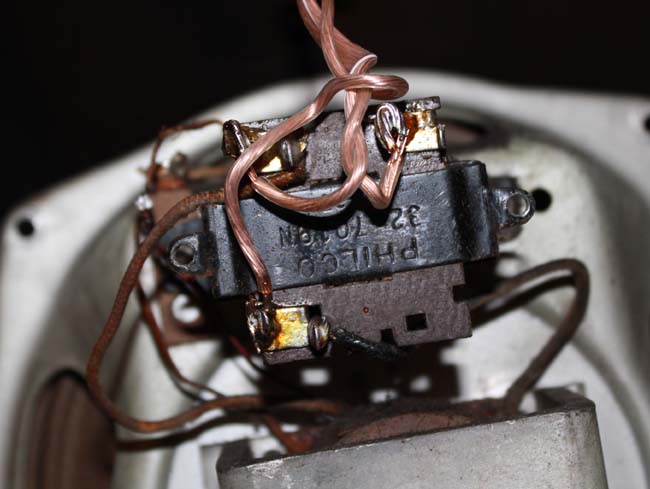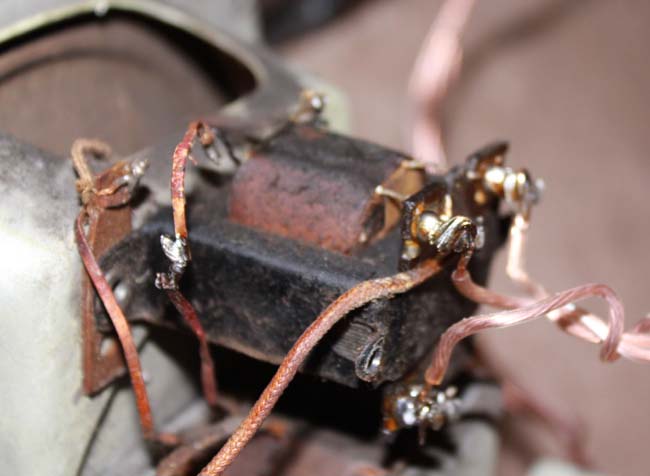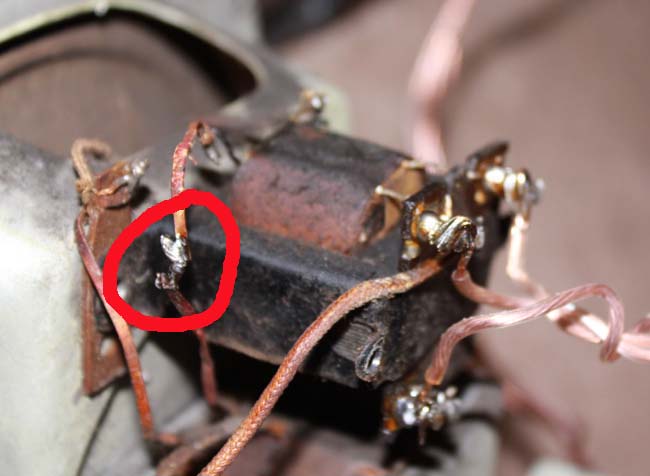Quick Question about a Schematic..
Posts: 15,307
Threads: 532
Joined: Oct 2011
City: Jackson, NJ
Actually the sch shows a speaker WITH hum bucking coil.
Good time to check if it is present in the real speaker.
As for the RC I am not sure it is a resonant trap (or do you mean a snubber?) and whether this kins of things would be effective. It might be simply letting some of the ripple in counter-phase (one goes through inductance, one through a cap) so when they combine at the output transformer's pin they cancel each other.
For a snubber to work here.....something has to resonate.
Posts: 1,113
Threads: 14
Joined: Feb 2013
City: Irvington, NY
Morzh, what you are in effect describing is a resonant circuit. For the inductive current to equal the capacitive current and cancel, their reactances have to be equal but out of phase.
This is exactly the situation in a parallel resonant circuit where the L and C reactances cancel and the impedance at the resonant freq ideally approaches infinity. Since this parallel resonant circuit is in series with the DC supply, a trap is formed and the 120 Hz component is not passed.
It really works pretty well. The 118 power supply uses a separate choke and resonating cap to trap the ripple freq. I actually connected a scope to both sides to see the ripple reduction. On the input side there was about 60 V P-P of ripple while at the output it was reduced to a fraction of a volt. Changing the cap value affected the null, so with the exact specified value what was left was only 60 Hz and higher harmonics, the 120 Hz component was totally gone!
Posts: 15,307
Threads: 532
Joined: Oct 2011
City: Jackson, NJ
Yes I would be describing a resonant circuit if the Z(l)=Z© if it weren't for that resistor.
However the resistor in the first place will shift the phase and will dampen the resonance.
I think they use the resistor to compensate for the field coil own resistance which is pretty close (1140 Ohm vs 1000 Ohms ) so the cap could be chosen to have the same impedance as the coil at the 60Hz.
The effect is the same during the resonance (counter-phased currents at the same frequency) but it is not really a resonance once you introduced the loss element in there.
(This post was last modified: 01-27-2014, 03:58 PM by morzh.)
Posts: 1,113
Threads: 14
Joined: Feb 2013
City: Irvington, NY
I am not sure why they added the resistor other than to reduce the Q of the circuit and the relative sharpness of the null. I did notice as I increased the capacitance over the resonant value, the higher harmonics increased due to the increased capacitive coupling present. Perhaps the resistor reduces this effect.
In any case, the extra resistor only adds to the series resistance of the field coil itself already present with respect to the RLC circuit formed.
Posts: 15,307
Threads: 532
Joined: Oct 2011
City: Jackson, NJ
Not sure why they did that.
Basically the greater the active resistance part, the less the angle between the currents in each leg will be. Which is not necessarily a good thing if we want them to cancel out.
I could put the equations here but we do not know the inductance.
Posts: 761
Threads: 56
Joined: Jul 2013
City: Kentucky
Quote:Jamie, did you check or replace resistor 65 and cap 66? Thes parts in combination with the field coil comprise a resonant trap which is tuned to the 120 Hz ripple frequency. If the resistor is open or high, or cap is off tolerance, the circuit will not be tuned to the ripple freq and you will experience increased hum.
Placing the speaker in the cabinet results in increased hum because of the acoustic baffle effect. The low freq response of the speaker is increased and therefore the hum becomes more apparent and noticeable.
Ok, when I bridged the 8mfd cap with the 20mfd cap, the hum disappeared, but voltages went too high for comfort. (At least too high for me to use this radio very much). I have a feeling it will eat tubes. I just bridged the cap to try and track down the problem area, not as a permanent fix.
Cap 66 is a .3mf bakelite block. I stuffed that cap. It was replaced, but not resistor 65. I've been working all day, but I have tomorrow off. Tomorrow, I will recheck that resistor and report back. I think it was a resistor between two lugs on that same bakelite block. If so, I certainly checked it and would have replaced it, were it out of spec.
The speaker in the radio is the speaker that came in it when I purchased it. I do not know if it is the original speaker though. How would I know if it has a hum bucking coil? What do I look for? I can post a photo of the back of the speaker if needed. It looks like a typical 1930's Philco speaker. I can't see a part number on it.
The artist formerly known as Puhpow! 8)
(This post was last modified: 01-27-2014, 06:00 PM by Jamie.)
Posts: 15,307
Threads: 532
Joined: Oct 2011
City: Jackson, NJ
Yes, do post the photos, and look for extra wires coming out of field coil or a turn of wire going around the field coil or somewhere around the field coil central post or even better, see if the output of the audio transformer solder DIRECTLY to the voice coil or there is an extra solder lug or anything that one of the transformer's output first go to and only THEN goes to teh second lug of the voice coil.
Posts: 761
Threads: 56
Joined: Jul 2013
City: Kentucky
The artist formerly known as Puhpow! 8)
Posts: 761
Threads: 56
Joined: Jul 2013
City: Kentucky


This speaker had an accessory pillow speaker attached when I bought this radio. I removed it, and soldered the leads together. I just mention this to explain the repaired wiring...
There is a part number on the transformer and it matches the number on the schematic parts list, which makes me think this is the original speaker for the radio.
The artist formerly known as Puhpow! 8)
Posts: 15,307
Threads: 532
Joined: Oct 2011
City: Jackson, NJ
The pics #2 and 4 seem to suggest there is a hum-bucking coil there.
If you look at the #4 you will see how the left output of the transformer (seems to be a piece of copper mesh or wire that attaches to the transformer output's black wire) instead of going directly to the voice coil contact (the solder post) goes inside the field coil, and then returns to solder to the voice coil (the mentioned solder post's pin).
This is the hum bucking coil.
Actually the very last picture in the second post (pic #7) also shows it well.
(This post was last modified: 01-28-2014, 10:10 AM by morzh.)
Posts: 599
Threads: 24
Joined: Jan 2014
City: Edmonton AB CA
Those two flat looking wires going to the underside of the field coil are the hum buck leads.
Gregb
Posts: 761
Threads: 56
Joined: Jul 2013
City: Kentucky
Ok, so... any suggestions? I am planning to swap the speaker wires, but decided to first wait and see what you guys say.
The artist formerly known as Puhpow! 8)
Posts: 15,307
Threads: 532
Joined: Oct 2011
City: Jackson, NJ
Which speaker wires?
Does the bucking coil soldering to the voice coil look original or was it changed?
You could try to reverse the bucking coil's ends, see if it exacerbate the hum or reduces it.
Q: how about the cap #68 and the resistor #70? Have you replaced the former and check the latter?
Posts: 15,307
Threads: 532
Joined: Oct 2011
City: Jackson, NJ
Last thing,
Have you tried grounding the chassis? Your filaments are all grounded on on end. Wonder if this would help.
Simple touching the chassis with your finger reducing the hum would tell if it could be a problem.
Any Ground (chassis) paths going through rivets that are loose/rusty?
Also see if by any chance the Ground path for filaments is used (tapped in the middle from transformer to filaments) for grounding other parts, like cathodes etc.
(This post was last modified: 01-28-2014, 10:28 AM by morzh.)
Posts: 761
Threads: 56
Joined: Jul 2013
City: Kentucky
Earlier in this thread, Raliegh suggested reversing the speaker leads. I hadn't decided which ones to reverse, I was going to look at the schematic and try to figure it out before attempting it.
All of the soldering on the speaker looks original, except for the place where I removed a switch. Someone had added a pillow speaker to the radio. They also added a switch by cutting a wire in the original speaker (I think this is the hum bucking wire?). It looked like the pillow speaker was always active, but you could switch on/off the original speaker. I removed the switch and soldered the wire back together.

The repair is circled in red..
Cap number #68 has been replaced. I will double check resistor #70 and #65.
The artist formerly known as Puhpow! 8)
(This post was last modified: 01-28-2014, 10:32 AM by Jamie.)
Users browsing this thread: 1 Guest(s)
|



